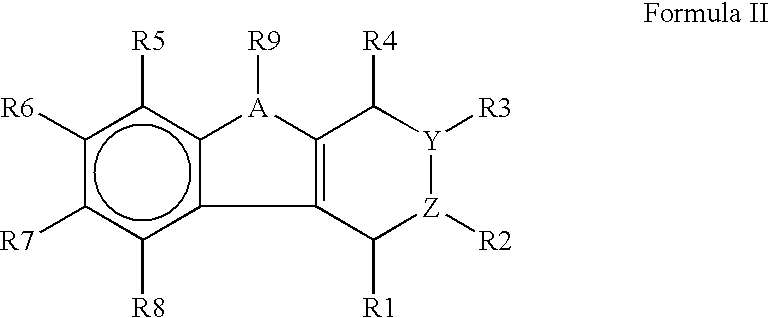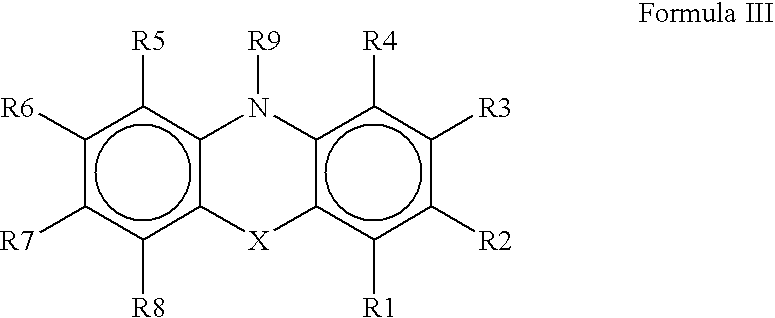Small molecule toll-like receptor (TLR) antagonists
- Summary
- Abstract
- Description
- Claims
- Application Information
AI Technical Summary
Benefits of technology
Problems solved by technology
Method used
Image
Examples
example 1
In Vitro Screening of a Library of Small Molecules for Inhibitors of Human TLR9
[0462] Candidate small molecules for initial screening were obtained from a commercially available library of 880 off-patent small molecules selected for structural diversity and proven bioavailability in humans (Prestwick Chemical Library). Human embryonic kidney HEK293 cells stably transfected with a human TLR9 (hTLR9) expression vector were incubated overnight in the presence of 50 nM CpG ODN 2006 (i.e., the EC50 concentration of ODN 2006) and selected small molecule candidate compounds at different concentrations ranging from 5×10−7 M to 5×10−5 M. TLR9 activity was assayed in terms of induction of a 6×NF-KB-luciferase reporter construct cotransfected in the cells. Results were measured as fold induction over baseline luciferase activity measured in the absence of ODN 2006 and compared to fold induction over baseline in the presence of the EC50 concentration of ODN 2006 alone. From this initial screen...
example 2
In Vitro Screening of a Library of Small Molecules for Inhibitors of Human TLR8
[0491] Candidate small molecules for initial screening were identified in an assay similar to that in Example 1 except HEK293 cells were stably transfected with a human TLR8 (hTLR8) expression vector and incubated overnight in the presence of 500 nM R848 (EC50 of R848 for TLR8) and selected small molecule candidate compounds at different concentrations ranging from 5×10−7 M to 5×10−5 M. TLR8 activity was assayed in terms of induction of a 6×NF-κB-luciferase reporter construct cotransfected in the cells. Results were expressed as fold induction over baseline luciferase activity measured in the absence of R848. From this initial screening a number of small molecules were identified as lead compounds and were categorized by structure and activity. Additional screening was performed in like manner using additional small molecules selected from another library or specifically prepared for this purpose. Result...
example 3
In Vitro Screening of a Library of Small Molecules for Inhibitors of Human TLR7
[0492] Candidate small molecules for initial screening were identified in an assay similar to that in Example 1 except HEK293 cells were stably transfected with a human TLR7 (hTLR7) expression vector and incubated overnight in the presence of 2 μM R848 (EC50 of R848 for TLR7) and selected small molecule candidate compounds at different concentrations ranging from 5×10−7 M to 5×10−5 M. TLR7 activity was assayed in terms of induction of a 6×NF-κB-luciferase reporter construct cotransfected in the cells. Results were expressed as fold induction over baseline luciferase activity measured in the absence of R848. From this initial screening a number of small molecules were identified as lead compounds and were categorized by structure and activity. Additional screening was performed in like manner using additional small molecules selected from another library or specifically prepared for this purpose. Results ...
PUM
| Property | Measurement | Unit |
|---|---|---|
| Immunostimulation | aaaaa | aaaaa |
| Immunogenicity | aaaaa | aaaaa |
Abstract
Description
Claims
Application Information
 Login to View More
Login to View More - R&D
- Intellectual Property
- Life Sciences
- Materials
- Tech Scout
- Unparalleled Data Quality
- Higher Quality Content
- 60% Fewer Hallucinations
Browse by: Latest US Patents, China's latest patents, Technical Efficacy Thesaurus, Application Domain, Technology Topic, Popular Technical Reports.
© 2025 PatSnap. All rights reserved.Legal|Privacy policy|Modern Slavery Act Transparency Statement|Sitemap|About US| Contact US: help@patsnap.com



